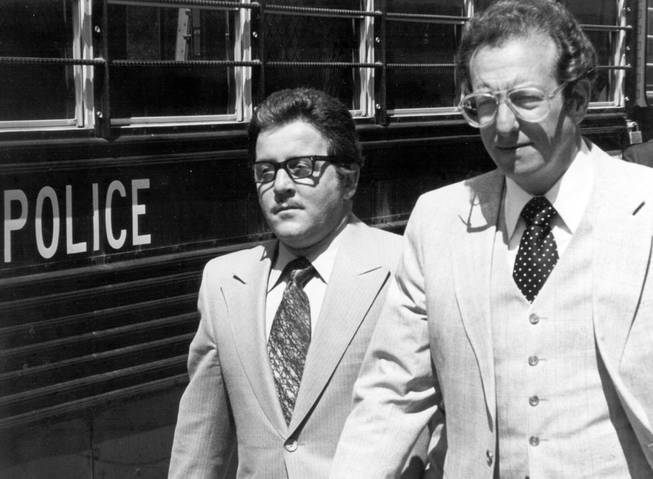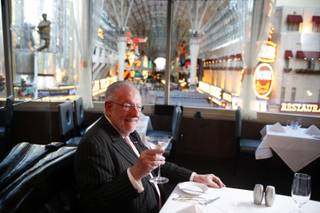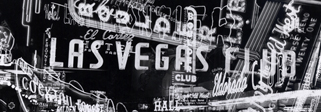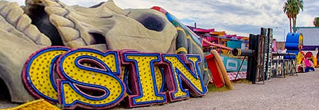
Sun File Photo
Mobster Tony Spilotro, left, and his attorney, Oscar Goodman, walk side by side after a session of the Spilotro trial in 1986. Goodman is writing his memoirs, including his days representing alleged mobsters and three terms as mayor of Las Vegas.
Wednesday, Jan. 16, 2013 | 2 a.m.
Former Las Vegas Mayor Oscar Goodman’s memoir about his life as a mob lawyer, his three terms as the “happiest mayor in the universe” and his new career as the head of the Las Vegas Convention and Visitors Authority’s host committee hits bookstores June 4.
Goodman gave members of the Destination Services Association a preview of his book, “Being Oscar,” on Tuesday at the recently relocated Planet Hollywood restaurant at the Forum Shops at Caesars.
“I think the reason my book is going to be successful is because it’s Vegas,” Goodman told the group. “Anything with Vegas cannot miss. People love us. They’re fascinated by us.”
The book is being published by the movie-making Weinstein brothers.
Goodman said he is meeting with his publishers at the end of the week to go over some details of the manuscript he presented after writing for more than a year.
He said the book chronicles his childhood in Philadelphia, attending law school at the University of Pennsylvania and his cross-country trek with his wife to Las Vegas, where friendly conversations at a blackjack table led to him representing the likes of Meyer Lansky and Anthony “Tony the Ant” Spilotro.
“You don’t become a mob lawyer by saying, ‘I want to be a mob lawyer.’ They don’t teach you that in law school,” he said.
Goodman said that while his wife — current Las Vegas Mayor Carolyn Goodman — was playing low-stakes blackjack at the Hacienda, he met a dealer who eventually contacted him about filing for bankruptcy. Goodman took the case and successfully filed the petition for $250.
Weeks later, he got another call from a pit boss at the casino seeking a criminal lawyer.
‘“I don’t know if he’s a criminal lawyer, but call Oscar Goodman; he’s a good guy,’ the pit boss told me. So they called me,” Goodman said.
In a late-night meeting, Goodman said he went to the home of a well-known Las Vegas gambler and was handed an envelope and told, “Here’s three dimes, and you better win the case.”
“I didn’t even know what ‘three dimes’ was, but I opened the envelope and found 30 $100 bills,” Goodman said. “I had never seen that much money at one time in my life. And I began to sweat because I was told that I better win the case.”
It turned out to be a criminal defense for the stepbrother of an East Coast mob figure. It was Goodman’s first federal case and it was conducted in downtown Las Vegas’ federal courthouse — now the home of downtown’s Mob Museum.
The trial occurred on Valentine’s Day in 1966. When the trial ended, the client’s brother, also a reputed mobster, asked Goodman if it was better if the jury was out a short time or a long time. Goodman assured the man that the longer the jury was out, the better. But by the time they had made the short walk from the courthouse to Goodman’s downtown office, the jury had returned with a verdict.
“I think they felt sorry for me,” Goodman said of the jury. “I could try the case 1,000 times and (in my mind) I’d lose it 999 times. But this time, they gave me a Valentine’s Day gift and they found this young man not guilty.”
Goodman talked to the group about another of his favorite things — downtown development.
He applauded efforts to develop the tavern district on East Fremont Street, the Smith Center for the Performing Arts and the Mob Museum, which he said has already paid back the $400,000 the city had invested in it.
He’s optimistic about the redevelopment of the Lady Luck resort into the Downtown Grand and said his wife has hopes of turning the Downtown Transportation Center “into a Faneuil Hall” — a historic downtown Boston gathering place.
Goodman also offered a story about the Cleveland Clinic Lou Ruvo Center for Brain Health.
“I was there when Frank Gehry, the great architect, saw it for the first time,” he said. “When he first saw it — I give you my word of honor — he began to cry. When he saw the inside of that place, he said, ‘This is even more than I ever dreamed of when I was creating it.’ If you’ve seen it, it’s absolutely phenomenal with great artwork. But more important than that, the Cleveland Clinic is running the medical end of it.”


 Explore Las Vegas’ past and present
Explore Las Vegas’ past and present Boomtown: The Story Behind Sin City
Boomtown: The Story Behind Sin City Neon Boneyard: A 360° look
Neon Boneyard: A 360° look Mob Ties: See the connections
Mob Ties: See the connections Implosions: Classic casinos crumble
Implosions: Classic casinos crumble
Join the Discussion:
Check this out for a full explanation of our conversion to the LiveFyre commenting system and instructions on how to sign up for an account.
Full comments policy